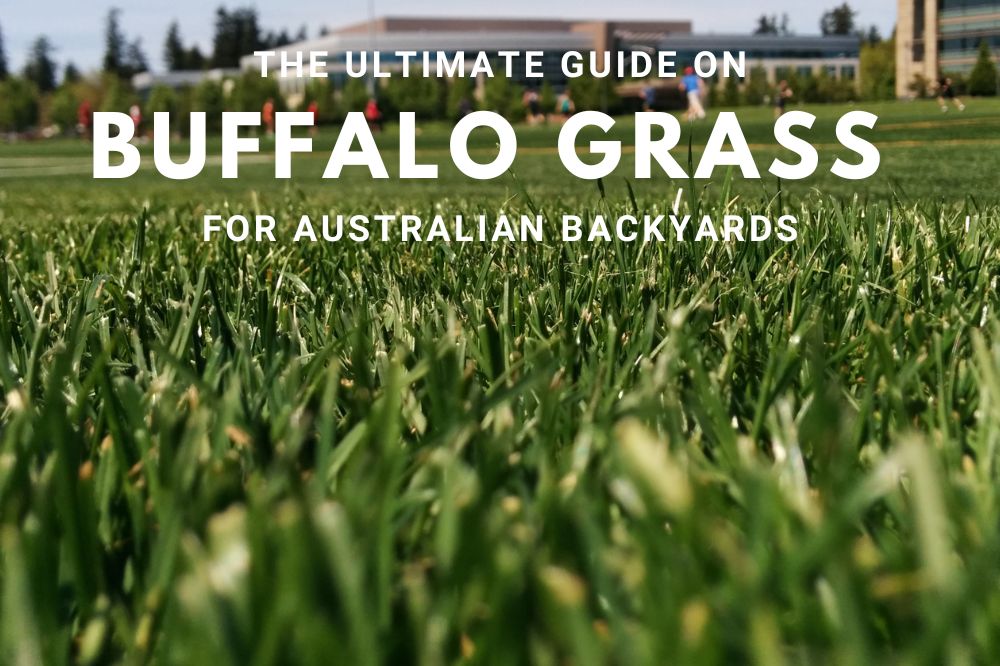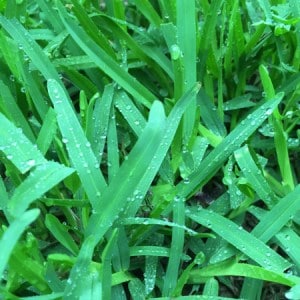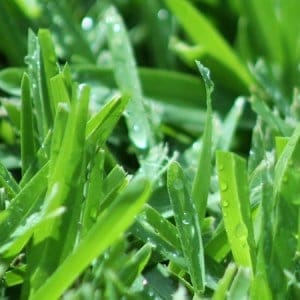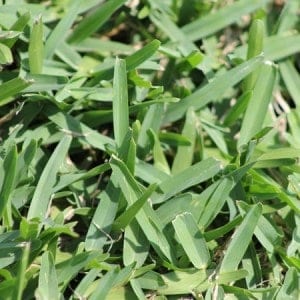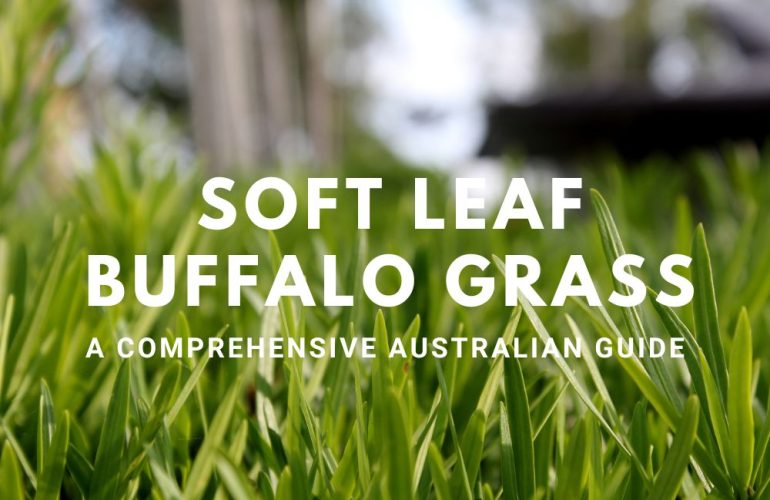The Australian Buffalo Grass Guide
Buffalo grass has built up a solid reputation as a really tough turf for Australian backyards.
It’s a hardy, warm-season grass that thrives in Australia’s hot climate. It can withstand periods of drought while maintaining its lush green colour and is one of the easiest turf types to look after in Australia.
What is Buffalo Grass?
Buffalo Grass is a type of warm season grass that is found in Australia. It has wide, flat leaves and can be green or blue-green. This grass grows quickly with runners above and below the ground.
Buffalo Grass is good for places with lots of people because it spreads fast and grows thick. It also needs less care than some other kinds of grass and can grow in different types of soil.
How to Identify Buffalo Grass
To identify Buffalo Grass, examine the grass for its colour, leaf shape, and texture. It is usually blue-green or dark green in colour, and its leaf blades are broader and flatter than most other grasses.
Check if it has a V-shaped fold on the leaves. Also, observe the growth pattern to determine if it is spreading through stolons or rhizomes. Finally, measure the height of the grass to identify if it is Buffalo Grass.

What does buffalo grass look like
Buffalo Grass is an attractive and eye-catching grass, boasting a lush dark green or blue-green hue.
It spreads both above the ground via runners (stolons) and below the ground through rhizomes. Expert tip: when folded in half, one may identify a V-shaped crease down its middle!
Buffalo Turf Grass Varieties
There are a number of Buffalo varieties each with some really special characteristics that make them a standout choice for your lawn.
Here at Atlas Turf we have 4 buffalo grass varieties:
Each of these varieties shares many wonderful characteristics but they also display some differences too. See our comparison table below:
| Buffalo Features | Sir Walter | Sapphire | Palmetto | Matlilda |
|---|---|---|---|---|
| Leaf texture | Coarse | Fine | Long broad | Soft, medium fine |
| Traffic hardiness | High | Medium-high | Medium-high | Excellent |
| Full Sun | Excellent | Excellent | Best | Excellent |
| Shade tolerance | Medium | Best | Medium | Excellent |
| Mowing requirements | Medium | Low | Low | Medium to high |
Where to Buy
Our high quality Buffalo Turf is available for buy online, we have a wide range of buffalo turf varieties available for delivery across the Sydney and surrounding regions, including Sir Walter Buffalo Turf.
See below for range of our premium buffalo turf products.
Sir Walter Buffalo Turf
Sir Walter is Australia’s most popular buffalo turf, featuring a thick and dense texture with great wear tolerance due to it’s thick growth habit. It is soft to the touch and does not require mowing as often as some other turf types.
Sir Walter Buffalo Grass is a no-fuss lawn that can be enjoyed all year round, with minimal maintenance and water requirements.
Buffalo Lawn Growth
A Sir Walter buffalo grass grows quickly and thickly, with runners stretching up to one and a half metres in length. It is best suited to lawns that receive full sunlight. It has a deep root system which helps to retain moisture in the soil, reducing water usage.
Lawn Colour
The colour of Sir Walter is a lush deep green, which will remain all year round with regular watering and fertilising. it has good winter colour retention, with minimal fading in the coldest months.
Lawn Leaf
Sir Walter is a soft leaf buffalo lawn, with a fine-textured broad leaf blade that is soft to touch and easy to mow. The leaves have a waxy coating which prevents moisture loss and helps to protect the plant from disease.
Weeds
The Sir Walter grass forms a dense root system which will protect against weed invasion to some extent. It is one of the best weed resistant turf varieties available on the market and is also very drought-tolerant.
Drought Tolerant
Most warm season grasses like Sir Walter Buffalo have a high drought tolerance as they are designed to cope with dry periods.
Sir Walter has a deep root system which helps to retain moisture in the soil, reducing water usage. This makes it an ideal choice for lawns in areas that are subject to water restrictions.
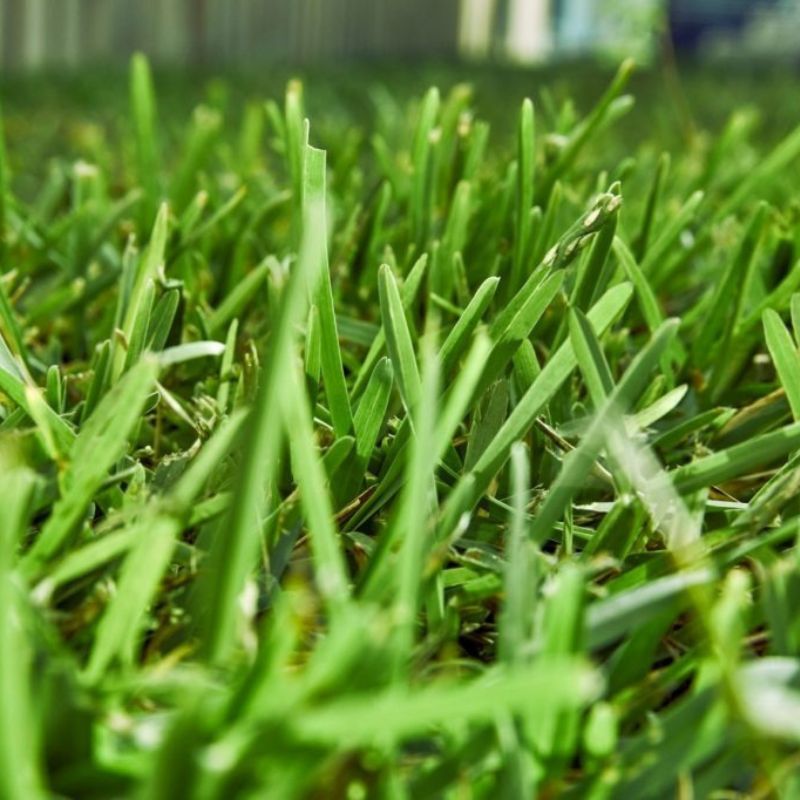
Sir Walter Buffalo Lawn Care
Sir Walter buffalo grass is renowned for its low maintenance requirements but regular watering, mowing, and applications of fertiliser will ensure your lawn stays looking its best regardless of what the weather, pests and weeds can throw at it.
To provide the best care for your Sir Walter lawn, follow these simple tips:
- Water deeply at least once a week during active growth periods.
- Mow your lawn regularly, no more than once a week in summer and at least every two weeks in winter.
- Fertilise your lawn during active growth periods using a slow-release fertiliser.
- Remove any weeds quickly before they can take over.
- Aerate and top-dress your lawn every year.
By following these simple tips, you can enjoy a healthy lawn, lush green Sir Walter lawn all year round.

The History of Sir Walter Buffalo Turf
Sir Walter Buffalo turf is an Australian-bred turf variety first developed in the 1980s.
Sir Walter is a buffalo grass and has undergone Lawn Solutions Australia testing to ensure its premium quality and is now the most popular turf variety in Australia.
It has sold over 100 million metres across the country which is an amazing accomplishment and a testament to its quality.
The hardy nature of the grass has made it perfect for residential and commercial properties in the tough Australian climate conditions, thriving in hot and dry weather, as well as cooler temperatures.

How to Mow Buffalo Grass
All Buffalo grasses do well in full sun but regular mowing will help keep your lawn looking its best.
Thatch, the layer of dead material at the base of grass blades — can become an issue if you don’t mow regularly.
A little thatch can help keep your lawn healthy during hot periods but you don’t want it to build up too much or it may cause the grass to overheat and even die.
Sir Walter and Palmetto are both low-thatch grasses but Palmetto produces the least thatch of all the Buffalo range. Avoid cutting your lawn too deeply.
Although a buffalo lawn will quickly recover when damaged, if you consistently cut your lawn too low it will eventually kill the grass.
The ideal height for a buffalo lawn is between 25 and 40mm. But keep the grass a little longer during the winter—around 60 to 70mm is best.
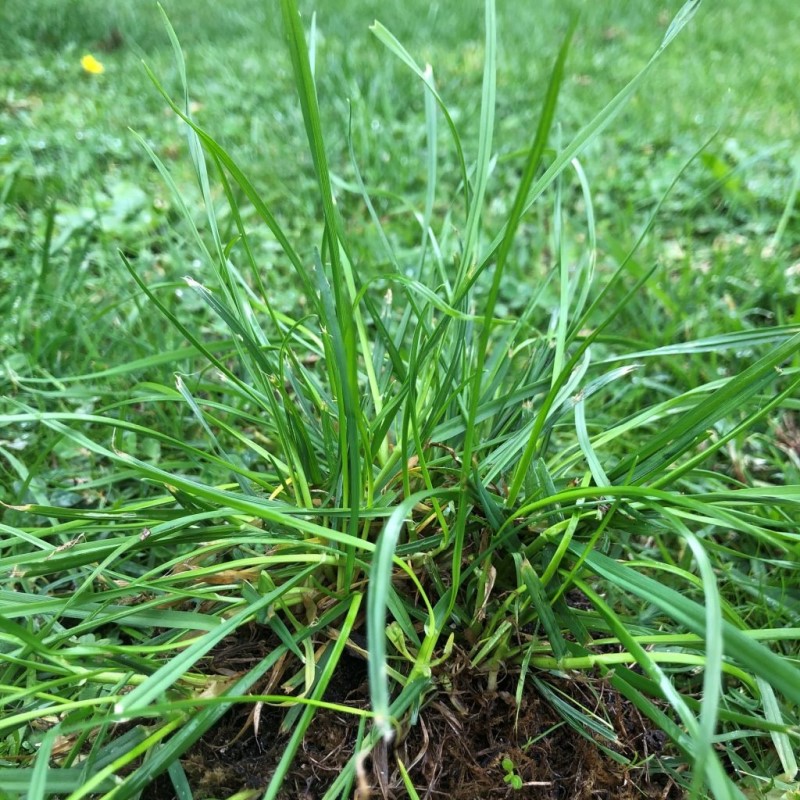
Buffalo Lawn Weed Control
Buffalo grasses form dense root systems which will protect against weed invasion to some extent, so it’s important to repair dead or bare patches quickly to prevent weeds taking hold.
Some herbicides are species-specific and it pays to check the instructions on the label carefully for the best times of the year to apply.
For weeds such as clover or couch, spot spraying with a selective herbicide is very effective.
September is a good time to use a selective broad spectrum spray that will kill weeds but will not affect Buffalo grass.
- Amgrow Lawn Weeder is a good choice.
- Amgrow Winter Grass Killer is very effective for the Couch weeds.
- Sedgehammer is likewise effective for killing weeds in Couch and Nutgrass and is best applied in spring or summer.
It’s a good idea to use pre-emergent sprays during autumn and spring to hit weeds on the head before they start to get a toehold, and be very careful if you choose to use glyphosate (Roundup). Consider applying it with a brush as spray drift will kill Buffalo.
It’s good practice to fertilise the ground before you lay new turf. Repeat two weeks after laying the lawn and then every couple of months for the first year, and once your lawn is established apply fertiliser in early spring, early summer and mid autumn.
Fertilisers help keep your grass green and healthy, they provide the nutrition your grass needs to recover from damage and will help it to resist pests and disease.
Slow release fertilisers are your best choice such as Grech’s Top Turf fertiliser or Seasol fertiliser.
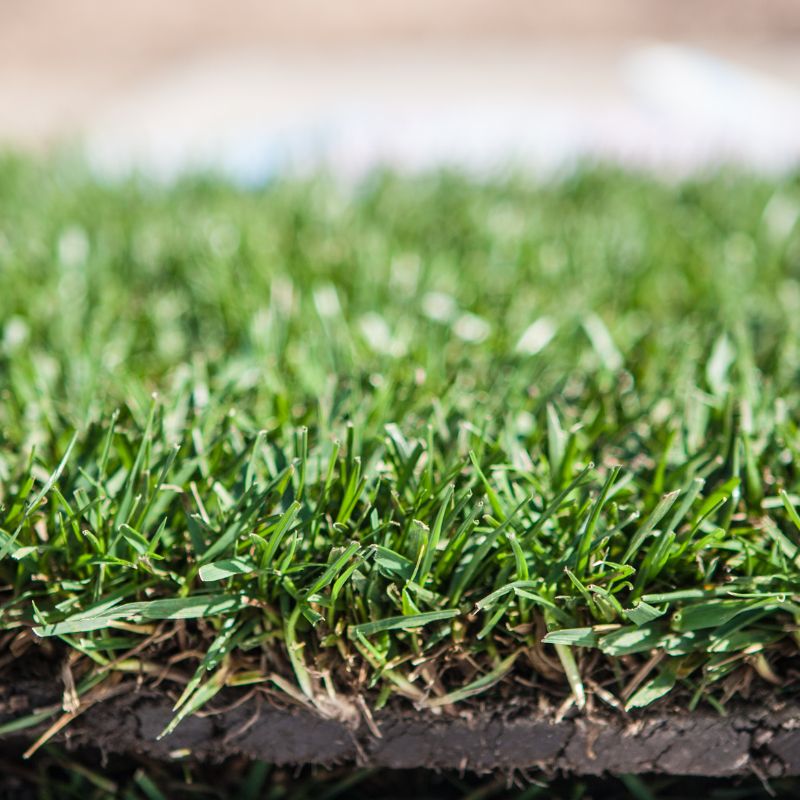
Buffalo Lawn Repair
If your Buffalo turf receives minor damage it will most likely repair itself. In more serious cases you may need to take some action. Brown Patch can be a problem for Buffalo grasses (like all warm season grass types) in more humid parts of the country.
Prevention is the best cure but if Brown Patch appears on your lawn try reducing watering. Only water in the morning. Never water at night—the fungus is spread through water.
Remove all lawn clippings and any other leaf matter that may increase humidity and reduce airflow. You may want to prune any shrubs or trees that shade the lawn to increase airflow as well. In particularly severe outbreaks you may need to use a fungicide but as with all poisons be careful.
It may take some months for the lawn to recover especially after a serious infestation. You may need to resow any dead patches in your lawn to prevent weeds taking hold. This is true whether it’s a fungus, lack of water or neglect that has caused the problem.
Bugs such as African Black beetles and Armyworms may damage your turf. If the infestation is serious you may want to treat with a pesticide.
Buffalo Grass
Frequently Asked Questions
Yes, Sir Walter Buffalo Grass is a Buffalo grass, and it’s a great choice for Australian homeowners.
Buffalo grass spreads by stolons (aboveground stems) which root where they touch the ground. This means that buffalo grass can spread quickly and easily, making it an ideal choice for lawns.
This allows it to fill in gaps in your lawn and create a dense, uniform growth pattern.
However, if you don’t want your Buffalo Grass to spread too much, you can control its growth through regular mowing and edging, as well as by applying herbicides to prevent the growth of new runners.
Growing buffalo grass is a great low-maintenance lawn and thrives in areas with 6-8 hours of sunlight each day, especially in the morning.
It prefers well-drained soils and does not tolerate sandy soils. The best time to plant buffalo grass is in late spring or early summer.
Here’s a simple outline you can follow for growing buffalo grass:
- Clear the area of weeds, rocks and debris.
- Select a buffalo grass variety suitable for your climate and soil type.
- Sow or lay turf evenly onto prepared soil.
- Water thoroughly and keep moist until grass is established.
- Apply slow-release fertilizer once grass is established.
- Mow regularly at 5-8cm height, removing no more than one third of blade at once.
- Regularly maintain grass with watering, fertilizing, and weed control.
- Enjoy your healthy buffalo grass lawn!
With the right care, your Buffalo Grass will be a lush and beautiful addition to your lawn. Enjoy!
Buffalo Grass is more shade tolerant than many other types of grass commonly grown in Australia, but it still requires some sunlight to grow properly.
In general, Buffalo Grass requires at least 3-4 hours of direct sunlight per day to thrive. If you’re considering planting Buffalo Grass in a shady area, make sure it receives some sunlight during the day and is not completely shaded.
Buffalo Grass is a relatively slow-growing grass compared to other common types of grass in Australia. Under optimal growing conditions, Buffalo Grass typically grows at a rate of about 10-20mm per week during the warmer months of the year.
However, growth rates may vary depending on factors such as temperature, soil quality, and water availability. With proper care and maintenance, Buffalo Grass can form a dense, attractive lawn over time.
It’s important to note that while Buffalo Grass may not grow as quickly as some other types of grass, it is generally more resilient and requires less maintenance, making it a popular choice for homeowners in Australia.
During the growing season, which typically runs from spring through to autumn in most parts of Australia, your Buffalo Grass may need to be watered once or twice a week. However, the exact frequency will depend on your local weather conditions and rainfall.
In cooler months, when growth is slower, you may be able to reduce the frequency of watering to once every two weeks or so.
The process is relatively straightforward. The most important thing to remember is that each roll of turf should be placed tightly next to the next roll without leaving any gaps.
To ensure optimal results, it’s best to lay your turf in a brickwork pattern with the length of the rolls parallel to each other.
Here’s a simple guide you can follow for laying your buffalo grass:
- Lay the turf: Put the turf on the ground, one piece at a time, like a puzzle. Make sure each piece fits snuggly against the other pieces with no gaps or extra pieces.
- Cut the edges: Use a sharp knife to fit it around the curves and corners of your area.
- Water the grass: Water both the soil and grass right away after you put down all of your turf pieces.
- Fertilize: After some time when your new grass is strong, use special fertilizer meant for Buffalo Grass to make it even healthier!
Read our full How to Lay Turf guide here
If your buffalo grass is turning yellow, it could be due to a number of factors. The most common causes are lack of nutrients, overwatering, soil compaction, and dog urine.
To fix the problem, you should first identify what is causing the yellowing. If it’s due to lack of nutrients, you can apply a slow-release fertilizer such as Scotts Lawn Builder.
If it’s due to overwatering or soil compaction, you should reduce watering and aerate the soil. If it’s due to dog urine, you can try using a pet-safe lawn treatment product.
Buffalo Grass is characterized by a wider leaf blade and a darker green hue, whereas Kikuyu Grass features an often coarser, wiry texture with narrower blades.
Yes, buffalo grass does have runners. Buffalo grass spreads primarily via runners (also called stolons).
These are above-ground stems that can root at the nodes, allowing the grass to spread and form a thicker lawn. It is also possible to repair bare patches in a lawn by using buffalo grass runners.

